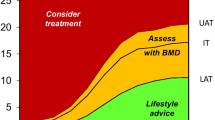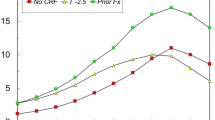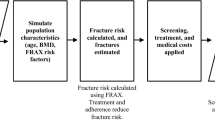Abstract
New assessment guidelines for osteoporosis in Japan include the use of the WHO risk assessment tool (FRAX) that computes the 10-year probability of fracture. The aim of this study was to determine the distribution of fracture probabilities and to assess the impact of probability-based intervention thresholds in women from Japan aged 50 years and older. Age-specific simulation cohorts were constructed from the prevalences of clinical risk factors and femoral neck bone mineral density to determine the distribution of fracture probabilities as assessed by FRAX. These data were used to estimate the number and proportion of women at or above a 10-year fracture probability of 5, 10, 15, 20, 25, and 30 %. In addition, case scenarios that applied a FRAX probability threshold of 15 % were compared with current guidance. In the absence of additional criteria for treatment, a 15 % fracture probability threshold would identify approximately 32 % of women over the age of 50 years (9.3 million women) as eligible for treatment. Because of expected changes in population demography, the 15 % fracture probability threshold would capture approximately 38 % of women over the age of 50 years (12.7 million women), mainly those aged 80 years or older. The introduction of a FRAX threshold of 15 % would permit treatment in women with clinical risk factors that would otherwise fall below previously established intervention thresholds. The incorporation of FRAX into assessment guidelines is likely to redirect treatments for osteoporosis from younger women at low risk to elderly women at high fracture risk.


Similar content being viewed by others
References
Kanis JA on Behalf of the World Health Organization Scientific Group (2008) Assessment of osteoporosis at the primary health-care level. Technical Report. WHO Collaborating Centre, University of Sheffield, UK. http://www.shef.ac.uk/FRAX
Kanis JA, McCloskey EV, Johansson H, Strom O, Borgström F, Odén A; National Osteoporosis Guideline Group (2008) Case finding for the management of osteoporosis with FRAX®: assessment and intervention thresholds for the UK. Osteoporos Int 19:1395–1408 (erratum 2009 Osteoporos Int 20:499–502)
Fujiwara S, Nakamura T, Orimo H, Hosoi T, Gorai I, Odén A et al (2008) Development and application of a Japanese model of the WHO fracture risk assessment tool (FRAX™). Osteoporos Int 19:429–448
Kanis JA, Oden A, Johansson H, Borgström F, Ström O, McCloskey E (2009) FRAX® and its applications to clinical practice. Bone (NY) 44:734–743
Kanis JA, Hans D, Cooper C, Task Force of the FRAX Initiative et al (2011) Interpretation and use of FRAX in clinical practice. Osteoporos Int 22:395–411
Compston J, Cooper A, Cooper C et al, on Behalf of the National Osteoporosis Guideline Group (NOGG) (2009) Guidelines for the diagnosis and management of osteoporosis in postmenopausal women and men from the age of 50 years in the UK. Maturitas 62:105–108
Grossman JM, Gordon R, Ranganath VK et al (2010) American College of Rheumatology 2010 recommendations for the prevention and treatment of glucocorticoid-induced osteoporosis. Arthritis Care Res (Hoboken) 62:1515–1526
Papaioannou A, Morin S, Cheung AM et al (2010) 2010 clinical practice guidelines for the diagnosis and management of osteoporosis in Canada: summary. CMAJ 182:1864–1873
Socialstyrelsen (2010) Nationella riktlinjer för rörelseorganens sjukdomar 2010—stöd för styrning och ledning. Preliminär version. Artikelnr 2010-11-15. http://www.socialstyrelsen.se
Czerwinski E, Kanis JA, Trybulec B, Johansson H, Borowy P, Osieleniec J (2009) The incidence and risk of hip fracture in Poland. Osteoporos Int 20:1363–1368
Kanis JA, Burlet N, Cooper C et al, on Behalf of the European Society for Clinical and Economic Aspects of Osteoporosis and Osteoarthritis (ESCEO) (2008) European guidance for the diagnosis and management of osteoporosis in postmenopausal women. Osteoporos Int 19:399–428
Association Suisse contre l’Ostéoporose (2010) Ostéoporose: Recommandations 2010. ASCO http://www.svgo.ch/content/documents/SVGO_Empfehlungen2010_V19April2010.pdf
Dawson-Hughes B, National Osteoporosis Foundation Guide Committee (2008) A revised clinician’s guide to the prevention and treatment of osteoporosis. J Clin Endocrinol Metab 93:2463–2465
Neuprez A, Johansson H, Kanis JA et al (2009) Rationalisation du remboursement des médicaments de l’ostéoporose: de la mesure isolée de la densité osseuse à l’intégration des facteurs cliniques de risque fracturaire. Validation de l’algorithme FRAX®. La Revue Médicale de Liège 64:612–619
Lippuner K, Johansson H, Kanis JA, Rizzoli R (2010) FRAX® assessment of osteoporotic fracture probability in Switzerland. Osteoporos Int 21:381–390
Committee of Japanese Guidelines for the Prevention and Treatment of Osteoporosis (2012) The Japanese guidelines for the prevention and treatment of osteoporosis, 2011 edn. Life Science Publishing, Tokyo (in Japanese)
Johansson H, Kanis JA, Odén A, Johnell O, McCloskey E (2009) BMD, clinical risk factors and their combination for hip fracture prevention. Osteoporos Int 20:1675–1682
Kanis JA, Oden A, Johnell O et al (2007) The use of clinical risk factors enhances the performance of BMD in the prediction of hip and osteoporotic fractures in men and women. Osteoporos Int 18:1033–1046
Looker AC, Wahner HW, Dunn WL et al (1998) Updated data on proximal femur bone mineral levels of US adults. Osteoporos Int 8:468–489
Population Division of the Department of Economic and Social Affairs of the United Nations. World Population Prospects: The 2008 Revision. http://esa.un.org/unpp
Orimo H, Sugioka Y, Fukunaga M et al (1998) Diagnostic criteria of primary osteoporosis. J Bone Miner Metab 16:139–150
Orimo H, Hayashi Y, Fukunaga M et al (2001) Diagnostic criteria for primary osteoporosis: year 2000 revision. J Bone Miner Metab 19:331–337
Hagino H, Katagiri H, Okano T, Yamamoto K, Teshima R (2005) Increasing incidence of hip fracture in Tottori Prefecture, Japan: trend from 1986 to 2001. Osteoporos Int 16:1963–1968
Hagino H, Furukawa K, Fujiwara S, Okano T, Katagiri H, Yamamoto K et al (2009) Recent trends in the incidence and lifetime risk of hip fracture in Tottori, Japan. Osteoporos Int 20:543–548
Cooper C, Cole ZA, Holroyd CR, Earl SC, Harvey NC, Dennison EM, Melton LJ, Cummings SR, Kanis JA, IOF CSA Working Group on Fracture Epidemiology (2011) Secular trends in the incidence of hip and other osteoporotic fractures. Osteoporos Int 22:1277–1288
Kanis JA, McCloskey E, Johansson H, Odén A, Leslie WD (2012) FRAX® with and without BMD. Calcif Tissue Int 90:1–13
Kanis JA, Johansson H, Odén A et al (2009) Bazedoxifene reduces vertebral and clinical fractures in postmenopausal women at high risk assessed with FRAX. Bone (NY) 44:1049–1054
McCloskey EV, Johansson H, Odén A et al (2009) Ten-year fracture probability identifies women who will benefit from clodronate therapy—additional results from a double blind, placebo controlled randomised study. Osteoporos Int 20:811–818
McCloskey EV, Johansson H, Oden A et al (2012) Denosumab reduces the risk of all osteoporotic fractures in postmenopausal women, particularly in those with moderate to high fracture risk as assessed with FRAX®. J Bone Miner Res. doi:10.1002/jbmr.1606
Kanis JA, Jönsson B, Odén A, McCloskey EV (2011) A meta-analysis of the effect of strontium ranelate on the risk of vertebral and non-vertebral fracture in postmenopausal osteoporosis and the interaction with FRAX®. Osteoporos Int 22:2347–2355
Kanis JA, Johansson H, Odén A et al (2010) A meta-analysis of the efficacy of raloxifene on all clinical and vertebral fractures and its dependency on FRAX. Bone (NY) 47:729–735
Acknowledgments
The analysis used in this article was supported by a grant from Lilly, Japan. Lilly, Japan had no input into the analysis plan or in the writing of this report.
Conflict of interest
None.
Author information
Authors and Affiliations
Corresponding author
About this article
Cite this article
Kanis, J.A., Johansson, H., Odén, A. et al. The distribution of FRAX®-based probabilities in women from Japan. J Bone Miner Metab 30, 700–705 (2012). https://doi.org/10.1007/s00774-012-0371-3
Received:
Accepted:
Published:
Issue Date:
DOI: https://doi.org/10.1007/s00774-012-0371-3




